Probably the most important step in the
recipe is to use the right flour type for this type of pastry. Julia
suggests using a low-gluten flour so the dough can be easily rolled
without becoming rubbery, etc. You could for instance use a mix of 1 part unbleached all-purpose and 2 parts unbleached pastry flour. She also adds tasteless oil to the mix, to help tenderize the dough.
Yeast Dough
Even if today’s dry yeast has a very
small chance of failing to do its job, I will give it a chance to prove
itself to be worthy of our croissant dough.
1 Tsp dry yeast1/4 Tsp salt
1/2 Tb sugar
1/4 cup warm water (not more than 110 degrees, otherwise you’ll kill the yeast)
Start by mixing all these ingredients
with the warm water until dissolved, and let it sit for 5 min. If the
yeast is active (and it should) it will form a soft foamy mass on its
surface:

Croissant Dough
No big secret here to be learned. Make
sure that when you measure “1 cup of flour” you actually sweep off the
excess with the edge of a knife so you will have a consistent quantity.
The quantities given here are good for a batch of 12 croissants. I usually double it and freeze a half of the dough (after I have the butter in it).
2 Cups of your flour mix (see Flour Options above).1 Tb sugar
3/4 Tsp salt
1/3 to 1/2 cups tepid milk
if using unbleached flour: 2 Tb vegetable oil (I used Canola)
if using bleached flour: 4 Tb vegetable oil


Blend all the above in a mixing bowl (don’t forget the yeast mix) with a spatula into a sticky mass, then out on the board:
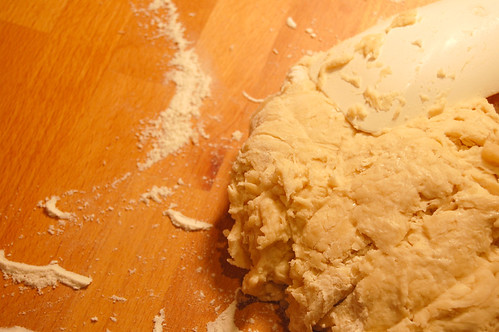
Time for some punching – works well when
you are mad. Julia suggests the lift-and-throw motion and as she talks
and demonstrates the moves, the dough gets stuck to her pastry scraper
and goes flying as she exclaims “Whew!” and goes on with her explanation
without any trouble… Typical Julia Child! Love it. Un-edited fun!

Keep on being rough with your dough for
about 3 minutes – it’ll be somewhat sticky at first but after a good
rapid fold and knead with the heels of your hands it will become
elastic, smooth and will not stick to your hands anymore:
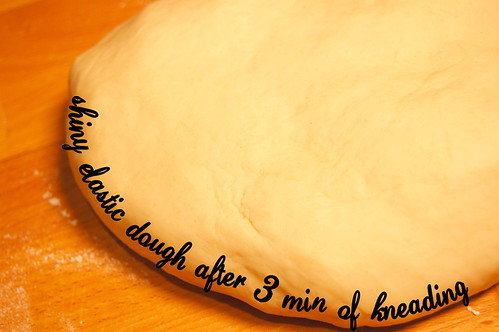
Time to rise. Plop the dough into a bowl
and do a criss-cross scissors snip on its surface to help it rise. Then
cover it with a plastic wrap, and let it rise until it becomes double
in bulk:
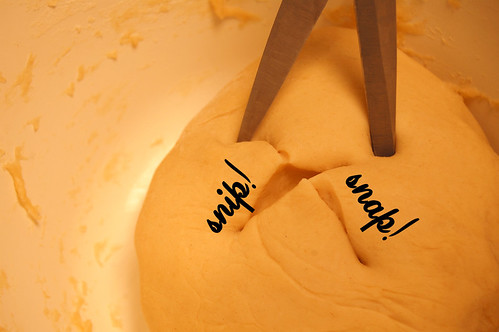
Rising time depends on the room temperature. I found that if I do this in the summer, rising is faster than in winter. About 1 to 1-1/2 hours at say 75 degrees will suffice. Don’t keep it in temperatures higher than 85 degrees or longer that needed (over-rise) since that wll impart an unpleasant taste. At this point you can retard the rising by placing the bowl in the refrigerator:

Then, punch it down into a flat circle, wrap it in wax-paper and chill it for about 20-30 minutes. The chilling is important as it makes working the dough much easier:

Rolls, Turns and Chills
If the croissant recipe would be considered a somewhat complicated procedure, than this particular step would probably be the one that will need more attention. What makes this basic yeast dough (good for bread, etc.) become a croissant dough is a good old stick of chilled butter. It is butter that makes the world turn. And it is butter that will make the 82 dough layers for our croissants:

Time is now to beat the daylight out of this chilled butter with your rolling pin.
The idea here, my friends, is to work the butter into a malleable
consistency, free of lumps and very fast, to keep the butter cold –
working with melted butter is just not fun:

Then finish this procedure by pushing
the whacked butter bits by bits out with the heel of your hand, so it is
completely lump-free:

Lovely,
huh? Having fun yet? Now, press your dough (I roll it) into an
approximate 9″ diameter circle, then form the butter into a 5″ square
(square-ish in my case) and place it on the top of your dough
(centered):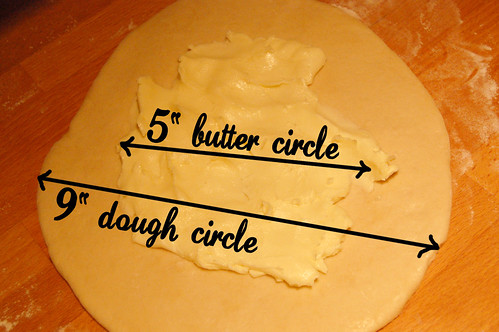

Now gently flip the dough edges (without ripping it!) over the butter and seal in the butter by pinching the dough: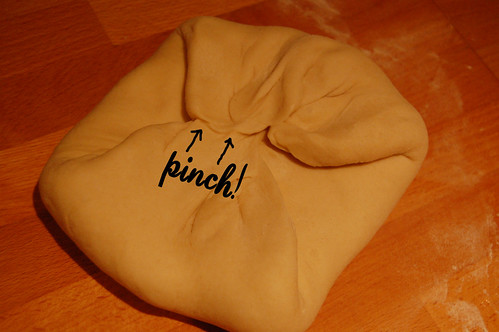

Voila!
now you have a nice package of dough with a stick of butter inside,
ready to be massaged into many layers. For that, flour your rolling pin
and both sides of your dough, place it on your board with the seal side
up and start gently rolling back and forth from the center towards the
edges to form a rectangle of about 15″ long and 5″ wide. It doesn’t HAVE
to be exact, but try to at least get close to that dimension. If there are butter bits that poke through, just pinch the dough over that spot to re-seal it. Also, if
the dough became too rubbery (read warm), chill it again for about 20
minutes and continue from where you’ve left it. What you want here is to
evenly spread the butter between the two dough layers (this gets you
ready for your next step):

Turns #1 and #2
Okay. What’s a turn in culinary lingo? Julia Child
defines it as having the dough folded like a business letter in 3 even
layers. And really, that’s exactly what it is. Gently fold the bottom of
your rectangle to the center of the dough then fold the top flap over
it the same way. That’s defined as turn #1:
Then once again, roll out the dough to the initial 15″ long and 5″ wide rectangle to prepare it for turn #2
just as before. Keep the edges as straight as possible (I re-align them
with the rolling pin). You will see that it will look more like a
rectangle than before. Rinse and repeat – you got it right?

By this time (after turn#2)
your dough needs some chilling to be able to roll it another 2 turns.
Leave it folded as a business letter, flour it lightly, wrap it in
wax-paper and place it in the fridge for about 1-2 hours: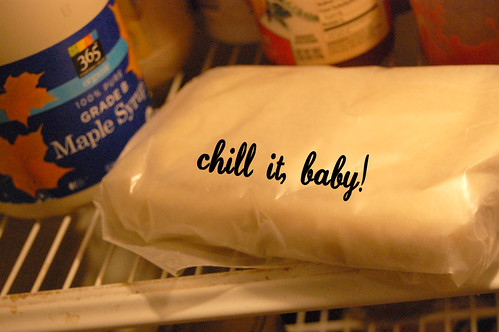

Turns #3 and #4
After the time spent in the fridge (1 to 2 hours) the dough is relaxed and ready for turn #3 and turn #4.
Really nothing special here. Just repeat the same process as for the
previous two turns – two rollings into the 15″ long and 5″ wide
rectangle and two business letter style folding. You will end up with 81
layers of butter between 82 layers of dough. Again, by this time the
dough is probably getting to rubbery to work with, so back in the fridge
it goes for a 2 hours chill.
Croissants Shaping
After the 2 hour chill, out of the fridge the croissant
dough comes and onto a lightly floured board. This time roll it into a
20″ long by 5″ wide rectangle. Try to keep the edges as straight as
possible:

Now, roll the one half of the croissants dough into a 12″ long by 5″ wide rectangle and cut it in thirds and chill two of the thirds:
Now take one of the thirds and roll it
into a 5-1/2″ square and cut it on the bias. Mine here doesn’t look
terribly square-ish but you get the idea:

Roll the triangles out to extend to
about 7″ long and shape it as much as you can into a isosceles triangle
(where two sides are equal in length). Now starting at the base, roll up
the dough towards the tip of the triangle, then bend it into a crescent
moon form, and place it on a buttered 12″ x 14″ baking sheet (not too
close to each other so they don’t fuse together while rising and baking)
with the tip of the triangle on the bottom so that it wouldn’t unwrap
during baking. Form the rest of the dough the same way into a total of
12 croissants, and let it rest for an hour covered with a plastic wrap. This might be a good time to get your oven going – set it to 475 degrees (mine takes about 45 minutes to heat up). You can freeze the risen croissants for later baking and pop them in the oven while frozen:
Glazing and Baking
Again, no rocket science here. Simple egg-wash. Paint the risen croissants with one egg beater mixed with 1/2 Tsp water:
Then
pop them in the pre-heated 475 degree oven and really – keep an eye on
them because they bake very fast. Usually something between 10 to 15
minutes depending on how dark brown you want them to look. Don’t do any
other activities during this fast bake – you will forgot about the oven
like I did so many times. I tend to leave them in until they turn
dark-brown. Let them cool on a rack for about 10 minutes and resist the
temptation of eating – the are HOT!:

Voila!
Julia
mentions in the episode that she could eat Croissants in the morning,
for lunch, for dinner, mid-morning or mid-night snack and so on. And I
don’t blame her. These evil Croissants are so wicked delicious
that can be enjoyed throughout the day. I tend to like them in the
morning and for lunch, as a sandwich, or simply with any sort of jam or
marmalade. Too bad we don’t have Le Figaro, the French news paper that
Julia grabs at the end of the show while sitting down and enjoying her caffé au lait, and freshly baked croissant.
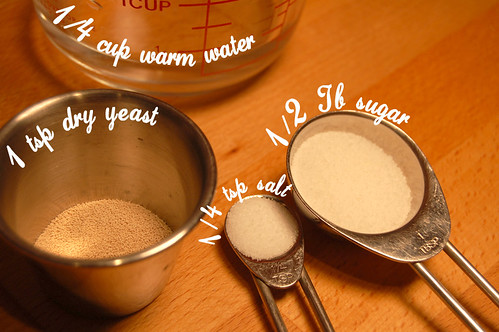


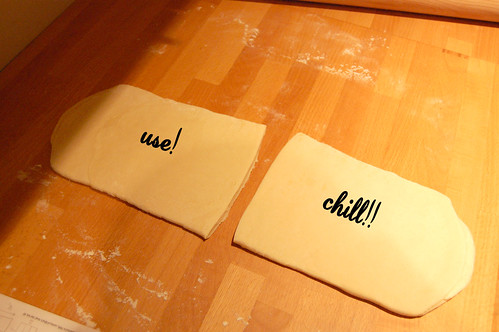


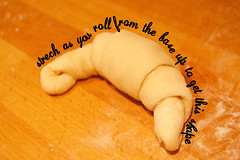
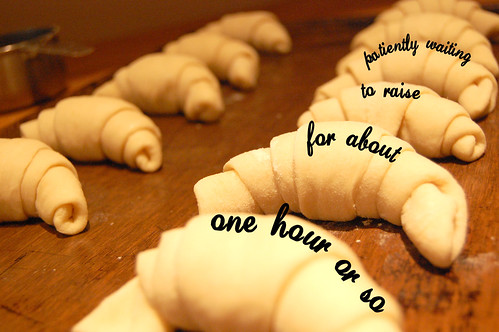




Nav komentāru:
Ierakstīt komentāru